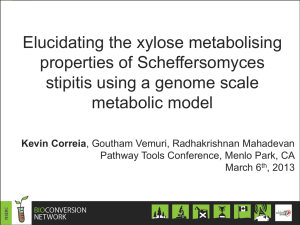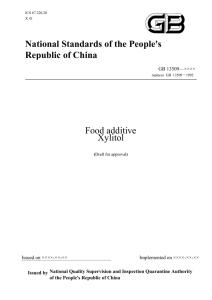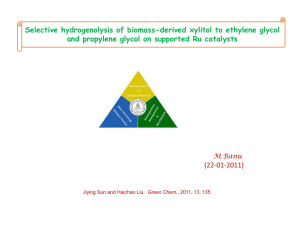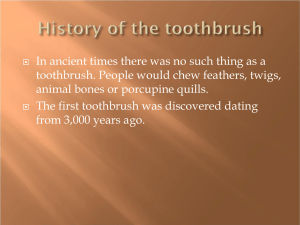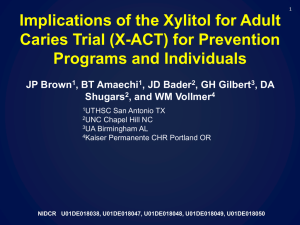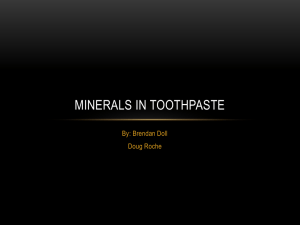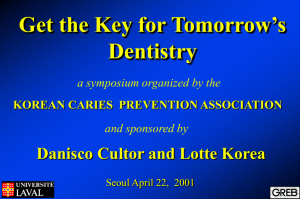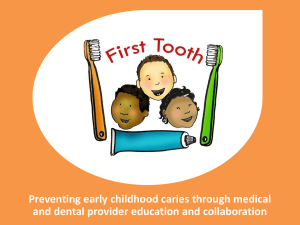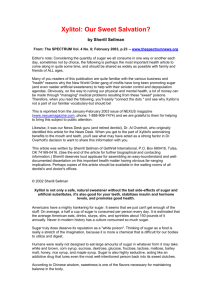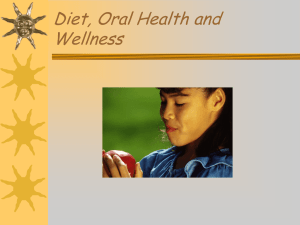Xylitol Use as Prevention for Tooth Decay
advertisement
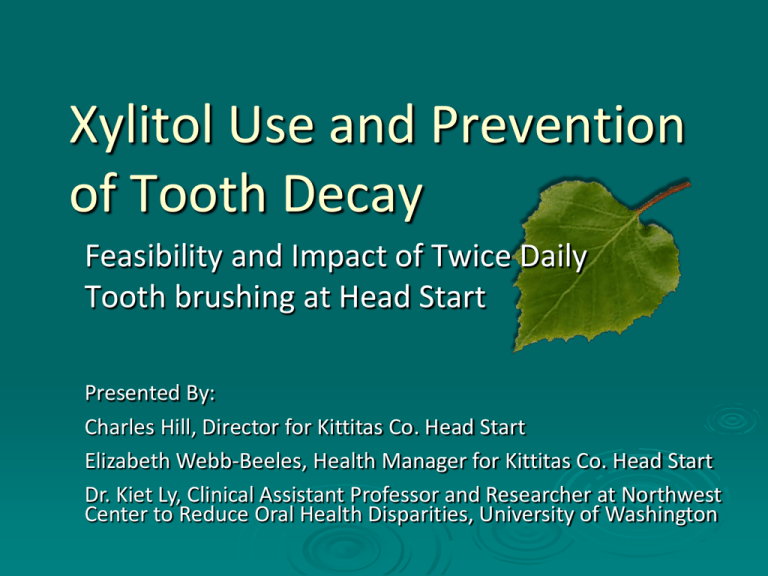
Xylitol Use and Prevention of Tooth Decay Feasibility and Impact of Twice Daily Tooth brushing at Head Start Presented By: Charles Hill, Director for Kittitas Co. Head Start Elizabeth Webb-Beeles, Health Manager for Kittitas Co. Head Start Dr. Kiet Ly, Clinical Assistant Professor and Researcher at Northwest Center to Reduce Oral Health Disparities, University of Washington Topics for this Session Oral health Human diet and sugars Causes of tooth decay Xylitol: What? Where? How? Northwest Center to Reduce Oral Health Disparities, University of Washington Kittitas County Head Start feasibility project Future study Oral Health A healthy mouth is integral to an individual’s total health. America’s oral health has improved over the past 50 years. Yet, tooth decay remains the single most common chronic childhood disease. Worse, tooth decay is rising in preschoolers Over 51 million hours of school are lost each year to dental problems. The Great Fluoride Debate Fluoride prevents tooth decay Possible adverse side effect Mottling of permanent teeth due to the swallowing of excessive fluoride by young children (dental fluorosis) Benefit to health in preventing decay outweigh the risk? Progression of fluorosis Increased Risk Poor & Minority children suffer: Twice as many tooth decay as their more affluent peers, and their disease is more likely to be untreated. 12 times more restricted-activity days than children from higher-income families. Poor & ethnic minority groups experience more oral health problems. Individuals with medical or physical disabilities are also at greater risk. Human Diet and Sugars 135 lbs. of sugar per person per year Cause of Dental Caries Streptococcus mutans (S. mutans) bacteria is the leading cause of tooth decay. Plaque is a sticky film on teeth Bacteria like S. mutans feast on sugars and starches found on teeth. Bacteria metabolism produce acids that “eat away” teeth surfaces causing weak spots that can become cavities. What is Xylitol? Naturally occurring sweetener in the same class as sorbitol, maltitol, mannitol, erythritol. Found in fibers of trees, fruits, and vegetables. The human body produces several grams of xylitol a day. FDA approved as a food additive (sweetener) in 1963. How Xylitol Works Cannot be fermented by plaque bacteria. Microorganisms like S. Mutans do not readily metabolize xylitol into energy sources. Inhibits growth and metabolism of S. mutans and reduces dental plaque. Thus reduces S. mutans levels in plaque and saliva = Reduction in acid production Reduction in dental caries Xylitol Prevents Tooth Decay 1975: First study on the effects of xylitol conducted in Turku, Finland. One year study, 102 subjects Chewing Gum Each Day S-group: 4 pieces of Sucrose gum X-group: 4.5 pieces of Xylitol gum The mean increment of decayed, missing and filled tooth surfaces: S-group: 2.92 > X-group: 1.04 Xylitol Prevents Tooth Decay II 2002: Swedish study on the effects of xylitol toothpaste on the reduction of S. mutans. 6 month study, 155 subjects. Toothpaste and brushing Twice Daily Colgate Total with 10% xylitol Colgate Total with triclosan (no xylitol) Colgate Total without triclosan or xylitol (Placebo) Four saliva and plaque samples gathered: Baseline, 2 months, 4 months, 6 months Xylitol Field Trial 1994: Estonia school study on xylitol gum. 3-year long period, 740 children (10 year olds). Xylitol or “Control” gum groups. Daily dose of 5 grams of xylitol in xylitol group. Xylitol groups showed 35-60% reduction in caries incidence. Significant difference from control. How Much Xylitol? Research suggests 5 to 10 grams of xylitol per day for effectiveness. Humans tolerate up to approx. 45 grams/day. 5% may have cramps, some have loose stools. Humans adapt, start slowly. Symptoms should disappear. Sorbitol is worse than xylitol. Where Can You Find Xylitol? Who Has Endorsed Xylitol for Caries Prevention? 1988 –Finnish Dental Association 1989 – Swedish 1990 – Norwegian 1992 – British 1993 – Irish & Canadian 1995 – Estonia Many others since Most recently, the Dental Hygienist Association in Arizona and Hawaii Northwest Center to Reduce Oral Health Disparities Oral health disparity means a disproportionate burden and risk of poor dental health in a particular population. Mission: The Northwest Center to Reduce Oral Health Disparities conducts community-based research. We focus on solutions to dental and oral health disparities among vulnerable, rural, or under-served groups, particularly lowincome families with children. Disparities Center Xylitol Studies Xylitol Chewing Gum Dose response Frequency response Xylitol Snacks Xylitol Gummy Bears Xylitol Syrup Xylitol Toothpaste NOT ALL XYLITOL PRODUCTS PROVEN EFFECTIVE Kittitas County Head Start Project 2007-2008 Academic Year Information gathering, used historical data. Epic Dental Xylitol-Fluoride toothpaste. School Twice-daily tooth brushing after meals Home Toothbrushes and toothpaste sent home to families twice during year Encouraged brushing at home Challenges Success Preparation of supplies Children were Facilities receptive Encouraged more frequent brushing Parents liked it Time Home tracking Parent Survey End of Study Survey, spring 2008 57 surveys returned 35 English 22 Spanish 12% had two children in program 82% were enrolled for 6 months or more Survey Results Frequency of brushing at home Child: 65% brushed 2 times/day Child: 23% brushed 3 or more times/day Adult: 60% brushed 2 times/day Adult: 30% brushed 3 times/day Use of Xylitol toothpaste at home 9% of children did not use 76% of childre used it half of the time 42% of parents used the toothpaste 35% of other family members used the toothpaste Overall Positive Response 40% of the respondents would purchase xylitol toothpaste. 44% were not sure 67% of respondents would allow their child to participate in future studies. 30% said maybe 80% of respondents wanted more information on xylitol. Study Design The observational group from 2007-2008 Fluoride and xylitol toothpaste Tooth brushing twice a day Sent home xylitol toothpaste and tootbrushes The historical control group data gathered from 2006-2007 class Fluoride only toothpaste Tooth brushing once a day Sample Size Small sample size limited scope of the study The whole program participated (123 slots - 105 Head Start, 18 ECEAP) however only: 41 children received 2 dental exams* during the 2006-2007 school year 17 children received 2 dental exams* during the 2007-2008 school year *Excludes dental visits for follow-up treatment. Results of the Project Small sample size likely cause for lack of significant results, however trends indicate: Less children in the xylitol-fluoride group had an increase in dental caries than fluoride only group. Children with 2 exams Children with dmft increase % children with dmft increase Fluoride Only 41 15 37% “dmft” = decayed, missing, filled teeth Xylitol Fluoride 17 2 12% Results Continued Dental caries to increase in most children between .5 to .7 for each year of age. Xylitol-fluoride toothpaste group showed less increase in dental caries (8%) from baseline than the fluoride only toothpaste group (34%). Baseline Mean dmft Follow-up Visit Mean dmft Mean dmft Increment % change from Baseline T-test∆ in dmft increment Fluoride Only 3.63 4.85 1.22 34% Xylitol Fluoride 3.59 3.63 0.29 8% 0.019 Mean dmft Increment Mean Baseline dmft 5.00 4.50 1.22 0.29 4.00 3.50 3.00 2.50 2.00 3.63 3.59 1.50 1.00 0.50 0.00 Fluouride only Xylitol Fluoride Conclusions Xylitol-fluoride toothpaste appears to enhance protection from dental caries. It is feasible to integrate twice-daily tooth brushing into the program. Families need to be encouraged to use xylitol at home. Additional funds are needed for supplies (toothbrushes, toothpaste, sinks). Future Study NIH Grant, two years One year of data collection Xylitol-fluoride and Fluoride only Twice-daily or once-daily Classroom assistants to help with tooth brushing and data collection New sinks and computers Interested? Want more information? Dr. Kiet Ly Northwest Center to Reduce Oral Health Disparities University of Washington Health Sciences B-530 Box 357480 Seattle, WA 98195 kietaly@uw.edu Liz Webb-Beeles Kittitas County Head Start PO Box 835 Ellensburg, WA 98926 lwebb@kitcohs.org
